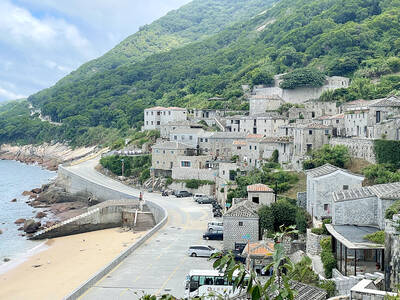Modern technology could make Chinese medicinal powders more easily available to consumers, the Department of Health said as it unveiled a new technique for converting herbs into powders.
Traditional Chinese medicinal powders have many disadvantages, said Yu Chien-chih (余建志), the leading researcher on the project, which was commissioned by the department’s Committee on Chinese Medicine and Pharmacy.
For example, the ingredients in the powder could deteriorate owing to moisture in the air, the taste is sometimes too bitter and the medication volume too bulky, said Yu, also an assistant professor at China Medical University School of Pharmacy.
ANTI-MOISTURE
To solve the problem, Yu first applied an anti-moisture coating to the powder grains, which preserves them for longer periods, decreases unpleasant taste and increases the stability of the ingredients.
With the medicine humidity-proof, he lowered the amount of excipient, a substance of no therapeutic value, but added to give it form. As a result, the medicine is more concentrated and patients can take less per day.
“Of 25g of traditional medicine consumed [today], about half of it is starch, a common form of excipient,” Yu said. “When refined, the 25g is reduced to 8.6g, only about one fourth of its original weight.”

The first two F-16V Bock 70 jets purchased from the US are expected to arrive in Taiwan around Double Ten National Day, which is on Oct. 10, a military source said yesterday. Of the 66 F-16V Block 70 jets purchased from the US, the first completed production in March, the source said, adding that since then three jets have been produced per month. Although there were reports of engine defects, the issue has been resolved, they said. After the jets arrive in Taiwan, they must first pass testing by the air force before they would officially become Taiwan’s property, they said. The air force

The Chinese military has built landing bridge ships designed to expand its amphibious options for a potential assault on Taiwan, but their combat effectiveness is limited due to their high vulnerability, a defense expert said in an analysis published on Monday. Shen Ming-shih (沈明室), a research fellow at the Institute for National Defense and Security Research, said that the deployment of such vessels as part of the Chinese People’s Liberation Army (PLA) Navy’s East Sea Fleet signals a strong focus on Taiwan. However, the ships are highly vulnerable to precision strikes, which means they could be destroyed before they achieve their intended

GLOBAL: Although Matsu has limited capacity for large numbers of domestic tourists, it would be a great high-end destination for international travelers, an official said Lienchiang County’s (Matsu) unique landscape and Cold War history give it great potential to be marketed as a destination for international travelers, Tourism Administration Director General Chen Yu-hsiu (陳玉秀) said at the weekend. Tourism officials traveled to the outlying island for the Matsu Biennial, an art festival that started on Friday to celebrate Matsu’s culture, history and landscape. Travelers to Matsu, which lies about 190km northwest of Taipei, must fly or take the state-run New Taima passenger ship. However, flights are often canceled during fog season from April to June. Chen spoke about her vision to promote Matsu as a tourist attraction in

PAWSITIVE IMPACT: A shop owner said that while he adopted cats to take care of rodents, they have also attracted younger visitors who also buy his dried goods In Taipei’s Dadaocheng (大稻埕), cats lounging in shops along Dihua Street do more than nap amid the scent of dried seafood. Many have become beloved fixtures who double as photography models, attracting visitors and helping boost sales in one of the capital’s most historic quarters. A recent photo contest featuring more than a dozen shop cats drew more than 2,200 submissions, turning everyday cat-spotting into a friendly competition that attracted amateur and professional photographers. “It’s rare to see cats standing, so when it suddenly did, it felt like a lucky cat,” said Sabrina Hsu (徐淳蔚), who won the NT$10,000 top prize in